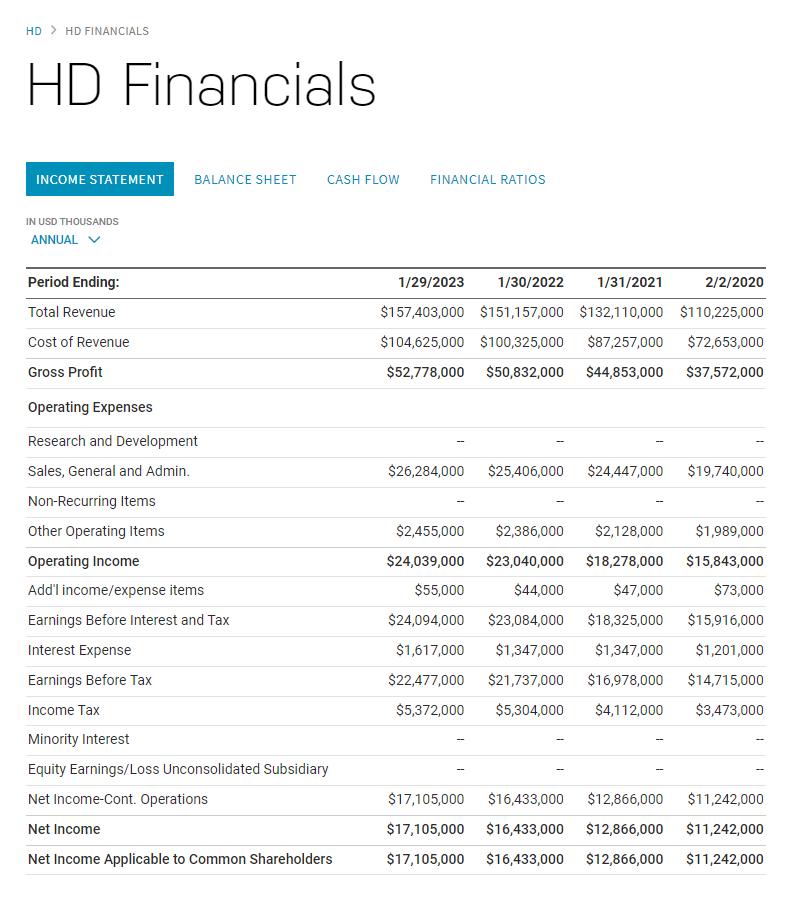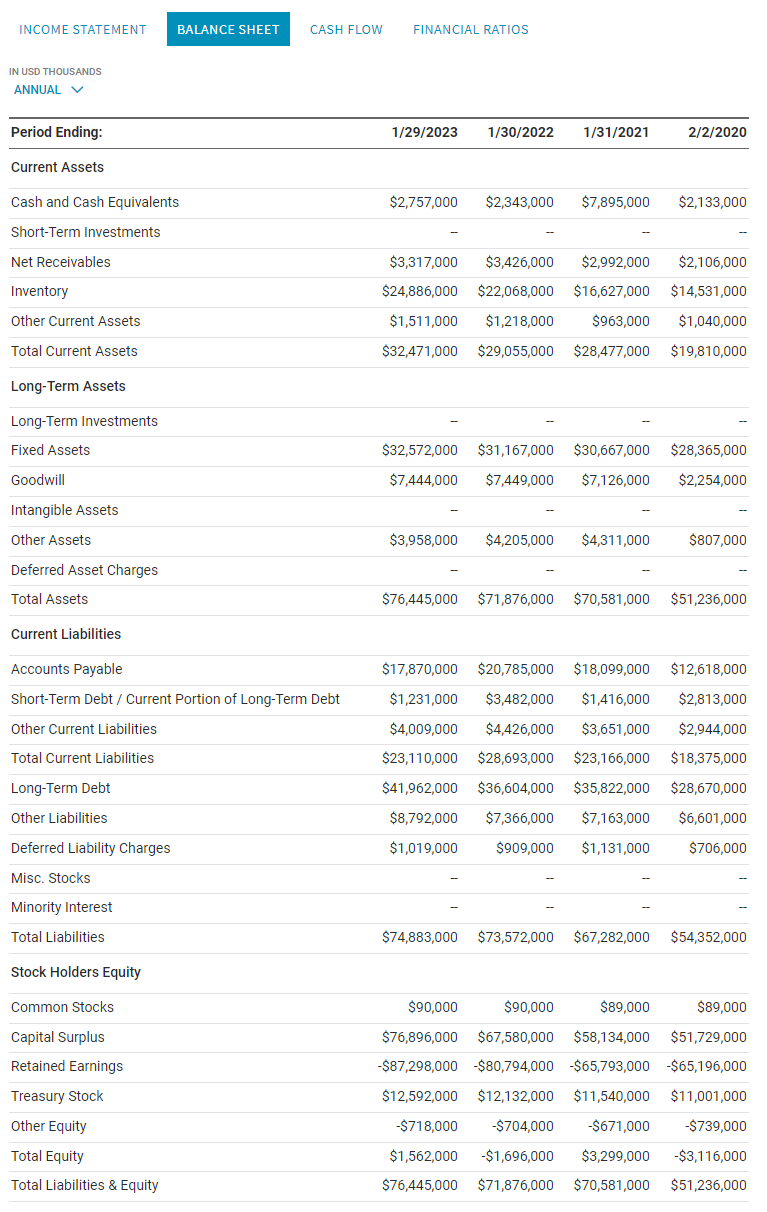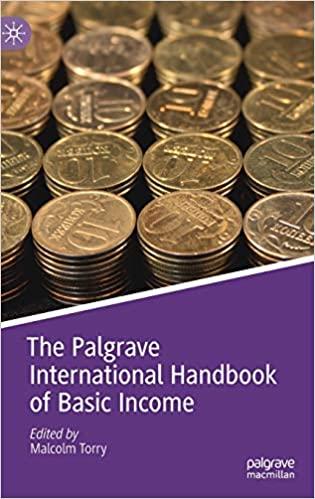Your boss was impressed with your presentation regarding the irrelevance of capital structure from Chapter 14 but, as expected, has realized that market imperfections like taxes must be accounted for.You have now been asked to include taxes in your analysis. Your boss knows that interest is deductible and has decided that the stock price of Home Depot should increase if the firm increases its use of debt. Thus, your boss wants to propose a share repurchase program using the proceeds from a new debt issue and wants to present this plan to the CEO and perhaps to the Board of Directors. Your boss would like you to examine the impact of two different scenarios, adding a modest level of debt and adding a higher level of debt. In particular, your boss would like to consider issuing $1billion in new debt or $5 billion in new debt. In either case, Home Depot would use the proceeds to repurchase stock. 1. Using the financial statements for Home Depot that you downloaded in Chapter 14, determine the average corporate tax rate for Home Depot over the last four years by dividing Income Tax by Earnings before Tax for each of the last four years. 2. Begin by analyzing the scenario with $1 billion in new debt. Assuming the firm plans to keep this new debt outstanding forever, determine the present value of the tax shield of the new debt. What additional assumptions did you need to make for this calculation? 3. Determine the new stock price if the $1 billion in debt is used to repurchase stock. a. Use the current market value of Home Depots equity that you calculated in Chapter 14. b. Determine the new market value of the equity if the repurchase occurs. c. Determine the new number of shares and the stock price after the repurchase is announced. 4. What will Home Depots D/E ratio based on book values be after it issues new debt and repurchases stock? What will its market value D/E ratio be? 5. Repeat Steps 24 for the scenario in which Home Depot issues $5 billion in debt and repurchases stock. 6. Based on the stock price, does the debt increase and stock repurchase appear to be a good idea? Why or why not? What issues might the executives of Home Depot raise that arent considered in your analysis?


HD > HD FINANCIALS INCOME STATEMENT BALANCE SHEET CASH FLOW FINANCIAL RATIOS IN USD THOUSANDS ANNUAL \begin{tabular}{|c|c|c|c|c|} \hline Period Ending: & 1/29/2023 & 1/30/2022 & 1/31/2021 & 2/2/2020 \\ \hline Total Revenue & $157,403,000 & $151,157,000 & $132,110,000 & $110,225,000 \\ \hline Cost of Revenue & $104,625,000 & $100,325,000 & $87,257,000 & $72,653,000 \\ \hline Gross Profit & $52,778,000 & $50,832,000 & $44,853,000 & $37,572,000 \\ \hline \multicolumn{5}{|l|}{ Operating Expenses } \\ \hline Research and Development & - & - & - & - \\ \hline Sales, General and Admin. & $26,284,000 & $25,406,000 & $24,447,000 & $19,740,000 \\ \hline Non-Recurring Items & - & - & - & - \\ \hline Other Operating Items & $2,455,000 & $2,386,000 & $2,128,000 & $1,989,000 \\ \hline Operating Income & $24,039,000 & $23,040,000 & $18,278,000 & $15,843,000 \\ \hline Add'l income/expense items & $55,000 & $44,000 & $47,000 & $73,000 \\ \hline Earnings Before Interest and Tax & $24,094,000 & $23,084,000 & $18,325,000 & $15,916,000 \\ \hline Interest Expense & $1,617,000 & $1,347,000 & $1,347,000 & $1,201,000 \\ \hline Earnings Before Tax & $22,477,000 & $21,737,000 & $16,978,000 & $14,715,000 \\ \hline Income Tax & $5,372,000 & $5,304,000 & $4,112,000 & $3,473,000 \\ \hline Minority Interest & - & - & - & - \\ \hline Equity Earnings/Loss Unconsolidated Subsidiary & - & - & - & - \\ \hline Net Income-Cont. Operations & $17,105,000 & $16,433,000 & $12,866,000 & $11,242,000 \\ \hline Net Income & $17,105,000 & $16,433,000 & $12,866,000 & $11,242,000 \\ \hline Net Income Applicable to Common Shareholders & $17,105,000 & $16,433,000 & $12,866,000 & $11,242,000 \\ \hline \end{tabular} INCOME STATEMENT BALANCE SHEET CASH FLOW FINANCIAL RATIOS IN USD THOUSANDS ANNUAL \begin{tabular}{|c|c|c|c|c|} \hline Period Ending: & 1/29/2023 & 1/30/2022 & 1/31/2021 & 2/2/2020 \\ \hline \multicolumn{5}{|l|}{ Current Assets } \\ \hline Cash and Cash Equivalents & $2,757,000 & $2,343,000 & $7,895,000 & $2,133,000 \\ \hline Short-Term Investments & - & - & - & - \\ \hline Net Receivables & $3,317,000 & $3,426,000 & $2,992,000 & $2,106,000 \\ \hline Inventory & $24,886,000 & $22,068,000 & $16,627,000 & $14,531,000 \\ \hline Other Current Assets & $1,511,000 & $1,218,000 & $963,000 & $1,040,000 \\ \hline Total Current Assets & $32,471,000 & $29,055,000 & $28,477,000 & $19,810,000 \\ \hline \multicolumn{5}{|l|}{ Long-Term Assets } \\ \hline Long-Term Investments & - & - & - & - \\ \hline Fixed Assets & $32,572,000 & $31,167,000 & $30,667,000 & $28,365,000 \\ \hline Goodwill & $7,444,000 & $7,449,000 & $7,126,000 & $2,254,000 \\ \hline Intangible Assets & - & - & - & - \\ \hline Other Assets & $3,958,000 & $4,205,000 & $4,311,000 & $807,000 \\ \hline Deferred Asset Charges & - & - & - & - \\ \hline Total Assets & $76,445,000 & $71,876,000 & $70,581,000 & $51,236,000 \\ \hline \end{tabular} Current Liabilities \begin{tabular}{lrrrr} \hline Accounts Payable & $17,870,000 & $20,785,000 & $18,099,000 & $12,618,000 \\ \hline Short-Term Debt / Current Portion of Long-Term Debt & $1,231,000 & $3,482,000 & $1,416,000 & $2,813,000 \\ \hline Other Current Liabilities & $4,009,000 & $4,426,000 & $3,651,000 & $2,944,000 \\ \hline Total Current Liabilities & $23,110,000 & $28,693,000 & $23,166,000 & $18,375,000 \\ \hline Long-Term Debt & $41,962,000 & $36,604,000 & $35,822,000 & $28,670,000 \\ \hline Other Liabilities & $8,792,000 & $7,366,000 & $7,163,000 & $6,601,000 \\ \hline Deferred Liability Charges & $1,019,000 & $909,000 & $1,131,000 & $706,000 \\ \hline Misc. Stocks & - & - & - & - \\ \hline Minority Interest & - & - & - & - \\ \hline Total Liabilities & $74,883,000 & $73,572,000 & $67,282,000 & $54,352,000 \end{tabular} Stock Holders Equity \begin{tabular}{lrrrr} \hline Common Stocks & $90,000 & $90,000 & $89,000 & $89,000 \\ \hline Capital Surplus & $76,896,000 & $67,580,000 & $58,134,000 & $51,729,000 \\ \hline Retained Earnings & $87,298,000 & $80,794,000 & $65,793,000 & $65,196,000 \\ \hline Treasury Stock & $12,592,000 & $12,132,000 & $11,540,000 & $11,001,000 \\ \hline Other Equity & $718,000 & $704,000 & $671,000 & $739,000 \\ \hline Total Equity & $1,562,000 & $1,696,000 & $3,299,000 & $3,116,000 \\ \hline Total Liabilities \& Equity & $76,445,000 & $71,876,000 & $70,581,000 & $51,236,000 \end{tabular}








